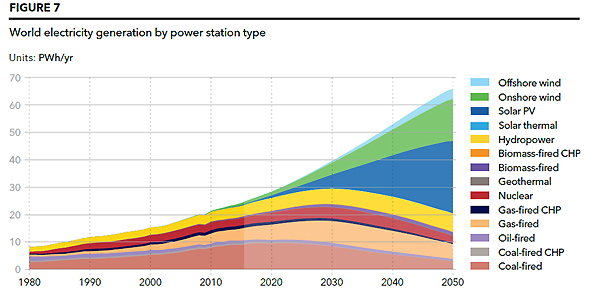Global grid capacity can be expected to triple by 2050, thanks to continued growth in renewables and a rapid electrification of energy demand, in particular through a progressive conversion of the world’s transportation sector to electric vehicles.
The projection is part of a study, Energy Transition Outlook 2018: Power Supply and Use, by “global quality assurance and risk management company” DNV GL.
 The report forecasts continuing rapid electrification, with electricity’s share of the total energy demand expected to more than double to 45% in 2050. The company says it will be driven by substantial electrification in the transport, buildings, and manufacturing sectors. In the transport sector, the uptake of private electric vehicles (EVs) will continue to escalate rapidly, with 50% of all new cars sold in 2027 in Europe expected to be EVs.
The report forecasts continuing rapid electrification, with electricity’s share of the total energy demand expected to more than double to 45% in 2050. The company says it will be driven by substantial electrification in the transport, buildings, and manufacturing sectors. In the transport sector, the uptake of private electric vehicles (EVs) will continue to escalate rapidly, with 50% of all new cars sold in 2027 in Europe expected to be EVs.
The surge in global electricity production will be powered by renewable sources accounting for an estimated 80% of global electricity production in 2050. As the costs for wind and solar continue to fall, those two energy sources are set to meet most of the electricity demand, with solar PV delivering 40% of electricity generation and wind energy 29%.
The rapid electrification will lead to major expansion of electricity transmission and distribution systems both in the length and capacity of transmission lines. DNV GL predicts that the total installed power line length and capacity will more than triple by 2050.
The system operators’ tasks will become substantially more complex; yet there may well be less energy flowing across the networks, resulting in fixed costs becoming a greater part of the bill.
The study authors say that high proportions of solar and wind will create a need for increased use of market mechanisms and changes to the electricity market fundamentals in many countries. This requires major regulatory intervention. Market based price signals are crucial to incentivize innovation and develop economically efficient flexibility options.
Despite major expansion of high-capital-cost renewables and electricity networks, energy will become more affordable, the authors believe. It is predicted that the total cost of energy expenditures, as a share of global GDP, will fall from 5.5% to 3.1%, a drop by 44%. Absolute energy expenditure will still grow by 30% over the forecast period, to USD 6 trillion/yr. DNV GL foresees a shift in costs, from operational expenditure, principally fuel, to capital expenditure. From 2030, more capital expenditures will go into electricity grids and wind and solar than into fossil-fuel projects.
The full Energy Transition Outlook 2018: Power Supply and Use report is available for a free download at eto.dnvgl.com.
